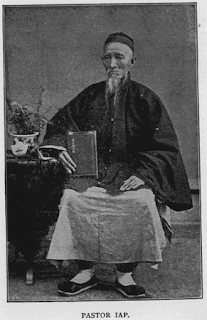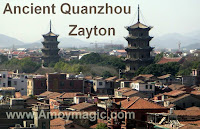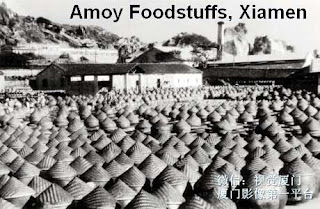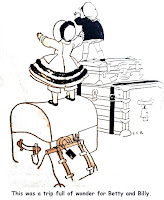I just received a fascinating email from Chris S. about his great grandfather in Amoy and Foochow, also talking about the French attack on Mawei and its Luoxing Pagoda (famous as the Star Pagoda). I have a full color French postcard that France put out to celebrate their murder of over 3,000 in their attack on Fuzhou to "teach China a lesson." The sheer barbarity of colonial powers in Asia only a century ago is astonishing; I keep hoping we'll learn from it. Thanks, Chris! Bill
Dear Dr. Brown
I enjoyed your website on Fujian. I thought you might find it interesting that my paternal grandmother and her 7 siblings were born on Pagoda Anchorage in the big home next to the Luoxing Pagoda. My great grandfather was a retired sea captain who decided to put on his land legs and settle down in Foochow as it was then called in the mid 1870's after a life of sailing the Pacific and Indian Oceans. He became the harbor master and at that time of course most of the big ships anchored there.
His name was Samuel Lewis Shaw, he was widowed and in about 70 years old. After being there a couple years a Japanese business associate came to visit and told him a man of his stature should not be alone so he brought his sister back from Japan and they married and had the 8 children including my grandmother.
My grandmother's older sister remembered the Battle of Foochow and recounted it in a radio interview before she died in Macao at the age of 103. She said her father had told the Chinese servants to lower the British flag that hung from their home on the Anchorage as the French fleet was approaching and would not enjoy seeing the Union Jack. But it did not get lowered and the French fired canon balls at their home, several whizzing through their large windows of the sitting room narrowly missing anyone in the room. The flag was immediately lowered and the shots aimed at them stopped.
My great grandfather died in 1908 and was buried in Foochow. Sadly, during the Korean war the Chinese revolutionaries who were much like the later day Red Guard dug up the cemetery and tossed all the bones and grave markers into the river [same thing happened with the centuries-old foreign cemetery in Amoy--but the Red Guards were as thorough in desecrating their own Chinese heritage as that of the foreigners; Bill B].
My father said he remembered visiting his Japanese grandmother one last time before he and my grandparents departed for England in 1929. My grandfather knew the war was coming and wanted to leave. My father said he was only 9 but he remembered running up to the top of the pagoda which had no railing and only a narrow pathway.
Well anyway, I did enjoy the website. I hope to go visit there someday, I have only been to Shanghai once a few years ago. My father went to Foochow in about 1988 and to Pagoda Anchorage said the big old home was still there but had been made into a school or something like that.
Chris Sxxxxxx
Enjoy Amoy!
www.amoymagic.com
Bill Brown Xiamen University www.amoymagic.com
Dear Dr. Brown
I enjoyed your website on Fujian. I thought you might find it interesting that my paternal grandmother and her 7 siblings were born on Pagoda Anchorage in the big home next to the Luoxing Pagoda. My great grandfather was a retired sea captain who decided to put on his land legs and settle down in Foochow as it was then called in the mid 1870's after a life of sailing the Pacific and Indian Oceans. He became the harbor master and at that time of course most of the big ships anchored there.
His name was Samuel Lewis Shaw, he was widowed and in about 70 years old. After being there a couple years a Japanese business associate came to visit and told him a man of his stature should not be alone so he brought his sister back from Japan and they married and had the 8 children including my grandmother.
My grandmother's older sister remembered the Battle of Foochow and recounted it in a radio interview before she died in Macao at the age of 103. She said her father had told the Chinese servants to lower the British flag that hung from their home on the Anchorage as the French fleet was approaching and would not enjoy seeing the Union Jack. But it did not get lowered and the French fired canon balls at their home, several whizzing through their large windows of the sitting room narrowly missing anyone in the room. The flag was immediately lowered and the shots aimed at them stopped.
My great grandfather died in 1908 and was buried in Foochow. Sadly, during the Korean war the Chinese revolutionaries who were much like the later day Red Guard dug up the cemetery and tossed all the bones and grave markers into the river [same thing happened with the centuries-old foreign cemetery in Amoy--but the Red Guards were as thorough in desecrating their own Chinese heritage as that of the foreigners; Bill B].
My father said he remembered visiting his Japanese grandmother one last time before he and my grandparents departed for England in 1929. My grandfather knew the war was coming and wanted to leave. My father said he was only 9 but he remembered running up to the top of the pagoda which had no railing and only a narrow pathway.
Well anyway, I did enjoy the website. I hope to go visit there someday, I have only been to Shanghai once a few years ago. My father went to Foochow in about 1988 and to Pagoda Anchorage said the big old home was still there but had been made into a school or something like that.
Chris Sxxxxxx
Enjoy Amoy!
OneMBA, Xiamen University
Amazon Book on our 3 decades in China:
"Off the Wall: How we Fell for China"
Amazon Book on our 3 decades in China:
"Off the Wall: How we Fell for China"
Bill Brown Xiamen University www.amoymagic.com



















